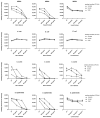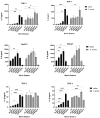Antimicrobial Activity and Wound-Healing Capacity of Birch, Beech and Larch Bark Extracts
- PMID: 35566174
- PMCID: PMC9102567
- DOI: 10.3390/molecules27092817
Antimicrobial Activity and Wound-Healing Capacity of Birch, Beech and Larch Bark Extracts
Abstract
Bark is a major by-product of woodworking industries. The contents of several wood species are known to harbor antimicrobial, antiviral, anti-inflammatory and wound-healing capacities. The aim of this work was to identify beneficial properties of Austrian larch, birch and beech bark extracts for their potential usage as additives or active ingredients in dermatological applications. Bacterial agar diffusion assay and resazurin-based broth microdilution assay were used to evaluate anti-bacterial activity. To gain more insight into the cellular response to bark extracts, viability-, scratch-assays and ELISAs were performed. Birch and beech extracts showed strong antimicrobial activities against Gram-positive bacteria, including Cutibacterium acnes, Staphylococcus epidermidis and MRSA. Wound closure was enhanced with birch and beech extracts as compared to controls in the scratch-assays. Whereas beneficial properties of birch bark components have previously been described, the similar effects of beech extracts are novel. The combined positive effect on wound-healing and antimicrobial activity has great potential for the treatment of various skin diseases, including acne in future dermal applications.
Keywords: antimicrobial activity; bark extract; beech; birch; larch; wound healing.
Conflict of interest statement
The authors declare no conflict of interest.
Figures





Similar articles
-
Antimicrobial activity and chemical composition of white birch (Betula papyrifera Marshall) bark extracts.Microbiologyopen. 2020 Jan;9(1):e00944. doi: 10.1002/mbo3.944. Epub 2019 Oct 3. Microbiologyopen. 2020. PMID: 31580010 Free PMC article.
-
Leveraging crude extracts from European tree bark to combat oxidative stress, enhance wound healing, and inhibit pathogenic bacterial growth.Sci Rep. 2025 Jul 1;15(1):21340. doi: 10.1038/s41598-025-06105-7. Sci Rep. 2025. PMID: 40596045 Free PMC article.
-
Dual function of active constituents from bark of Ficus racemosa L in wound healing.BMC Complement Altern Med. 2018 Jan 25;18(1):29. doi: 10.1186/s12906-018-2089-9. BMC Complement Altern Med. 2018. PMID: 29370854 Free PMC article.
-
Birch Bark Extract: A Review in Epidermolysis Bullosa.Drugs. 2023 Sep;83(14):1309-1314. doi: 10.1007/s40265-023-01935-z. Epub 2023 Sep 2. Drugs. 2023. PMID: 37658982 Review.
-
Methods of Betulin Extraction from Birch Bark.Molecules. 2022 Jun 5;27(11):3621. doi: 10.3390/molecules27113621. Molecules. 2022. PMID: 35684557 Free PMC article. Review.
Cited by
-
Antimicrobial Activity of Smilax china L. Root Extracts against the Acne-Causing Bacterium, Cutibacterium acnes, and Its Active Compounds.Molecules. 2022 Nov 29;27(23):8331. doi: 10.3390/molecules27238331. Molecules. 2022. PMID: 36500424 Free PMC article.
-
Plant Extracts as Skin Care and Therapeutic Agents.Int J Mol Sci. 2023 Oct 22;24(20):15444. doi: 10.3390/ijms242015444. Int J Mol Sci. 2023. PMID: 37895122 Free PMC article. Review.
-
Valorization of Extracted Bark for Particleboard Production: A Life-Cycle Impact Assessment.Polymers (Basel). 2025 Mar 28;17(7):925. doi: 10.3390/polym17070925. Polymers (Basel). 2025. PMID: 40219313 Free PMC article.
-
Antioxidant and Wound Healing Bioactive Potential of Extracts Obtained from Bark and Needles of Softwood Species.Antioxidants (Basel). 2023 Jul 4;12(7):1383. doi: 10.3390/antiox12071383. Antioxidants (Basel). 2023. PMID: 37507922 Free PMC article.
-
Antioxidative and Antimicrobial Evaluation of Bark Extracts from Common European Trees in Light of Dermal Applications.Antibiotics (Basel). 2023 Jan 9;12(1):130. doi: 10.3390/antibiotics12010130. Antibiotics (Basel). 2023. PMID: 36671331 Free PMC article. Review.
References
-
- Association of the Austrian Wood Industries Publikationen-FVHI Website Industry Report 2020. 2021. [(accessed on 7 February 2022)]. Available online: https://www.holzindustrie.at/infothek/publikationen/
-
- Kożuch A., Banaś J. The dynamics of beech roundwood prices in selected central European markets. Forests. 2020;11:902. doi: 10.3390/f11090902. - DOI
-
- Hansmann C., Stingl R., Teischinger A. Inquiry in beech wood processing industry concerning red heartwood. Wood Res. 2009;54:1–12.
-
- Dubois H., Verkasalo E., Claessens H. Potential of birch (Betula pendula Roth and B. pubescens Ehrh.) for forestry and forest-based industry sector within the changing climatic and socio-economic context of western Europe. Forests. 2020;11:336. doi: 10.3390/f11030336. - DOI
-
- Issarachot P., Sangkaew W., Sianglum W., Saeloh D., Limsuwan S., Voravuthikunchai S.P., Joycharat N. α-Glucosidase inhibitory, antibacterial, and antioxidant activities of natural substances from the wood of Derris reticulata Craib. Nat. Prod. Res. 2021;35:2858–2865. doi: 10.1080/14786419.2019.1678610. - DOI - PubMed
MeSH terms
Substances
Grants and funding
LinkOut - more resources
Full Text Sources
Other Literature Sources

